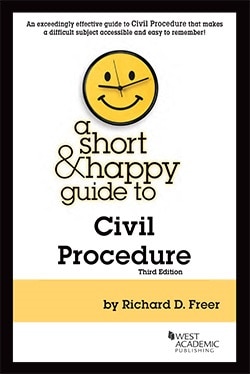CALI lessons allow you to work through issues in civil procedure in an interactive format in which you answer questions and explain your reasoning. If you are confused or have questions about an issue, a CALI lesson may provide a quick way to test and improve your knowledge.
Here are a few Civil Procedure Lessons that are helpful for 1Ls. A complete list of Civil Procedure Lessons is available at the CALI website.
The Federal Rules of Civil Procedure are available from the following online sources:
Hornbooks and study aids provide additional perspectives and clarifications to your assigned reading. Do not rely on them exclusively.
Unless otherwise noted, all materials below can be found in the Law Library's Study Aids Collection, which is located on the 7th floor of the Law Library.
 Freer's A short & Happy Guide to Civil Procedure by
Freer's A short & Happy Guide to Civil Procedure by  Understanding Civil Procedure by
This well-established treatise is premised on the assumption that the key to understanding the principles of civil procedure is to know why: why the principles were created and why they are invoked. The treatise is written to answer these questions as it lays out the basic principles of civil procedure. It also reflects the authors' belief that students of civil procedure can understand and appreciate complex principles when they are clearly presented; teaching civil procedure does not require dumbing it down.
The authors use the Federal Rules of Civil Procedure as a model, but they also refer to different state rules and doctrines where appropriate in order to present a representative cross-section of state models. Although they discuss important civil procedure cases in the text, thus supporting the most widely used civil procedure casebooks using these same cases, they also provide useful references to secondary sources and illustrative cases for the reader who wants to explore further.
Understanding Civil Procedure by
This well-established treatise is premised on the assumption that the key to understanding the principles of civil procedure is to know why: why the principles were created and why they are invoked. The treatise is written to answer these questions as it lays out the basic principles of civil procedure. It also reflects the authors' belief that students of civil procedure can understand and appreciate complex principles when they are clearly presented; teaching civil procedure does not require dumbing it down.
The authors use the Federal Rules of Civil Procedure as a model, but they also refer to different state rules and doctrines where appropriate in order to present a representative cross-section of state models. Although they discuss important civil procedure cases in the text, thus supporting the most widely used civil procedure casebooks using these same cases, they also provide useful references to secondary sources and illustrative cases for the reader who wants to explore further.
